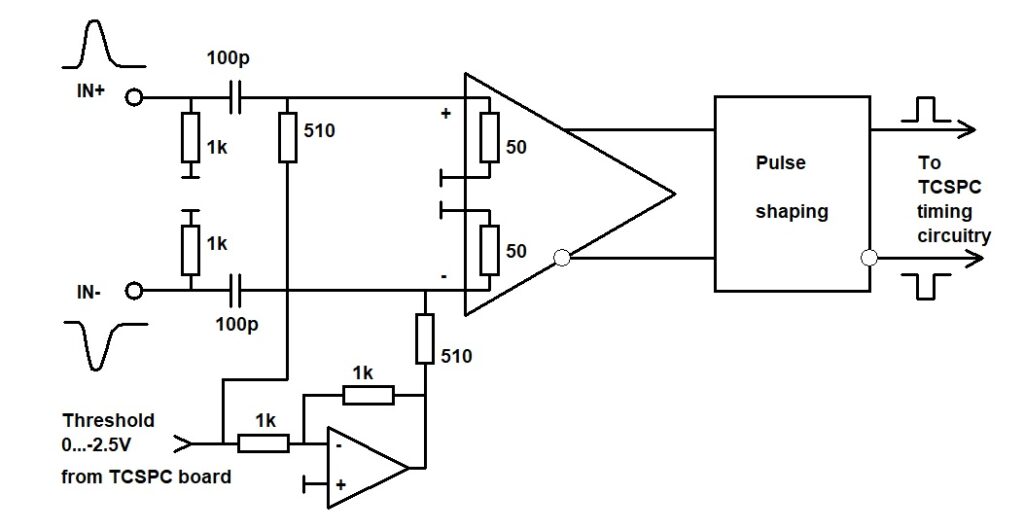The DIFDIS module is a differential-input discriminator for SPC-150N, SPC-150NX, and SPC-150NXX and SPC-160 TCSPC modules. It is used in combination with detectors the photon pulses of which have no or negligible amplitude jitter, such as SPAD modules or SSPD detectors. In these cases, the DIFFDIS module offers increased flexibility in terms of input pulse polarity, improved immunity against synchronous-noise pickup, and superior differential nonlinearity of the TCSPC measurement. The DIFDIS module is a direct replacement for the standard constant-fraction discriminator (CFD) module.
A Differential Discriminator for bh TCSPC Modules
Wolfgang Becker, Becker & Hickl GmbH, Berlin, Germany
Abstract: The DIFDIS module is a differential-input discriminator for SPC-150N, SPC-150NX, and SPC-150NXX and SPC-160 TCSPC modules. It is used in combination with detectors the photon pulses of which have no or negligible amplitude jitter, such as SPAD modules or SSPD detectors. In these cases, the DIFFDIS module offers increased flexibility in terms of input pulse polarity, improved immunity against synchronous-noise pickup, and superior differential nonlinearity of the TCSPC measurement. The DIFDIS module is a direct replacement for the standard constant-fraction discriminator (CFD) module.
Application
The DIFDIS module is a differential discriminator for SPC-150N, SPC-150NX, SPC-150NXX, and SPC‑160 TCSPC modules [1]. The module employs an ultra-fast leading-edge comparator. It is used in combination with detectors the photon pulses of which have no or negligible amplitude jitter, such as SPAD [1] modules or SSPD detectors [2, 3]. For these detectors, using a leading-edge discriminator instead of a CFD has advantages. The first one is that a leading-edge discriminator, especially a differential one, is less susceptible to synchronous high-frequency noise. It can thus improve the differential linearity of photon timing. Moreover, the DIFDIS conveniently triggers on negative pulses, positive pulses, and complementary pulses. It can thus be used for a number of detectors the output pulses of which are not directly compatible with the CFDs. Moreover, the use of complementary pulses can reduce geometric jitter of SSPD detectors, as suggested in [4]. The DIFDIS discriminator is a direct replacement for the standard SPC-150N CFD modules.
Principle
A photo of the DIFFDIS module is shown in Fig. 1, left, the principle in Fig. 1, right.


Fig. 1: CFDDIF differential discriminator. Left: Photo. Right: principle
The discriminator triggers on the difference voltage between the two inputs, IN+ and IN-. The inputs can be used simultaneously or separately. When only one of the inputs is used, IN+ is for positive pulses, IN- for negative pulses. The unused input should be connected to GND by a 50-W terminator. When used for differential signals (two signal lines with complementary pulses) the positive pulse is connected to IN+, the negative pulse to IN-. Please note that the inputs are AC coupled. A baseline offset of the input signals is therefore irrelevant.
The discriminator threshold is set by the CFD Threshold (sometimes also called 'CFD Limit Low') of the TCSPC system parameters. Please see [1], chapter 'SPCM Software'. The effect on the triggering is shown in Fig. 2. CFD Zero Cross has no effect on the DIFDIS discriminator.

Fig. 2: Effect of the Threshold setting on the trigger function
Test Results
Fig. 3 shows the electrical IRF of an SPC-150NXX module with the DIFDIS discriminator. The input pulse was connected to the -IN input of the discriminator, the +IN input was terminated with 50 Ω. The input pulse amplitude was -250 mV, the pulse width 1 ns. A delayed pulse was connected to the SYNC input of the SPC-150NXX module. Fig. 3 shows that the electrical IRF width is 2.9 ps fwhm, same as with the standard CFD-type discriminator [3].

Fig. 3: Electrical IRF of an SPC-150NXX module with a DIFDIS module. IRF width is 2.9 ps fwhm.
An 8-ns fluorescence decay detected with an id Quantique id100-20 detector is shown in Fig. 4. The output pulses of the id100 were connected directly to the +IN input of the DIFDIS. The excitation source was a bh BDS-405 ps diode laser with 40 ps FWHM pulse width. As can be seen from the figure, the decay function is reproduced cleanly, without noticeable traces of differential nonlinearity.

Fig. 4: Fluorescence decay recorded with an id100 SPAD module. Detector pulses connected to +IN input of discriminator.
Fig. 5 shows a fluorescence-decay function recorded with the DIFDIS and an HPM-100-06 hybrid detector. The excitation source was a BDS-405 ps diode laser, the fluorescence decay time was about 1.1 ns. Although the amplitude jitter of the single photon pulses from the HPM is not zero the system IRF has a FWHM of only 50 ps. This is only slightly longer than the IRF width of 38 ps, which was obtained with a similar laser and the SPC-150N standard CFD [5]. Please note the good differential linearity of the decay recording, which is a result of the increased noise immunity of the discriminator.

Fig. 5: Fluorescence decay recorded with ps diode laser and HPM-100-06 hybrid detector. IRF red, fluorescence blue. IRF width is 50 ps. 1 ns / division, time-channel width 3 ps.
References
1. W. Becker, The bh TCSPC Handbook, 9th ed., Becker & Hickl GmbH (2022). Electronic version available on www.becker-hickl.com. For printed copies please contact bh.
Contact
Wolfgang Becker
Becker & Hickl GmbH
Berlin, Germany
becker@becker-hickl.com

